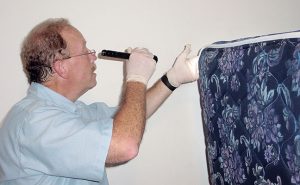-
Bed bug infestations follow a regular pattern, from introductions to infestations that can grow large over a period of months.
-
A trained professional can easily find heavy, and even intermediate infestations, but a single bug or a light infestation can be a challenge.

Gary Grossman, a district manager for Rose Pest Solutions, inspects a mattress for bed bugs.
Photo: Mark Sheperdigian, BCE
Since the great bed bug resurgence began, the problem faced by pest management professionals (PMPs) has been quite simply how best to find them and to kill them. That’s why, for the next few bed bug columns this year, I’d like to focus specifically on inspection.
Trained PMPs know where to look and how to identify all the signs of infestation, but single bugs and small infestations can be exceedingly difficult to find. Interceptors will trap bed bugs, but cannot tell you where they came from or how many others are still out there. A well-trained scent detection team can efficiently detect the scent of mild infestations and individual bugs, but the exact source of the scent may be difficult to determine. When each method is used where it excels, bed bug control can be achieved most efficiently.
Properly placed and maintained interceptors can catch introduced bed bugs or those that have wandered away from their harborage. Well-trained scent detection teams can detect the scent of live bugs, even when the bugs themselves cannot be found. They can lead you to an infestation no matter how few bugs there are. Where professionals excel is recognizing evidence and finding infestations.
The inspector understands that a bed bug infestation follows a regular and predictable path. It grows from a few individuals — or even a single mated female — into an actively breeding population that, if left untreated, grows larger until the population explodes. These exploded populations result in bugs of all stages crawling or being carried out to “seek their fortune.” Some will start populations of their own, but most will starve.
On their journey, they are the single bugs that may be found on a backpack, in a classroom or in a waiting room, where they often cause panic. Only when they reach a safe harborage with a regular meal and a mate will they begin a new population.
Most infestations are found in close proximity to the host. Sometimes they are farther away. They seek out dark, quiet, undisturbed spots. A good inspector with a quality flashlight can usually track them down. You can recognize the bugs live and dead, cast skins, dropping eggs and all the aspects of an infestation. Likely harborage sites require closer scrutiny.
Inspections work best when you can use your mind and powers of observation to guide you. Working close to the surface with plenty of light, move slowly and methodically through an area, examining all the quiet, dark recesses. A big key is to start where people sleep. In the living room, start with the most well-worn cushion on the couch or the seat with the best view of the TV. Move out slowly until you have covered the room. If there is an intermediate or heavy infestation, you will find it. But smaller infestations require more time and closer scrutiny; it may be best to deploy monitors or bring the dogs.
Contributor Mark Sheperdigian can be reached at shep@rosepest.com.
Leave A Comment